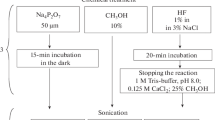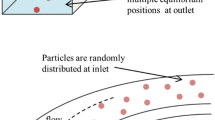Abstract
A system is described for the automatic sorting of zooplankton by isopycnic sedimentation at one gravity in density gradients of the silica sol Ludox AM containing 1% w/v sodium trimetaphosphate or 1% w/v dextran sulfate. The apparatus, called a “Rho Spectrometer”, consists of a 15.6–1 cylinder, a moveable piston for displacing the gradient from the top, and an ejector tube for collecting successive layers of the gradient. A gradient generator suitable for up to 30 Rho Spectrometers is also described. In a typical separation, 100 ml or so of preserved zooplankton are layered over a 13–1 gradient, which is 0 to 45% v/v in Ludox AM. Following an overnight period of sedimentation and equilibration, fish eggs are recovered from the top of the gradient, invertebrates from the central part of the gradient, and fish larvae from the bottom of the gradient. In many cases 90% of the fish larvae are separated from 95% of the invertebrates. Rho spectrometry should facilitate the analysis of large numbers of plankton samples through a substantial decrease in the amount of manual sorting required. However, in its present state of development, it is not suitable for all plankton samples; the zone of herring larvae, for example, is strongly overlapped by a number of invertebrates. In addition, samples heavily contaminated with Phaeocystis spp. or hydroids fail to sediment freely.
Similar content being viewed by others
Literature Cited
Bowen, R.A., J.M. St. Onge, J.B. Colton, Jr. and C.A. Price: Density-gradient centrifugation as an aid to sorting planktonic organisms. I. Gradient materials. Mar. Biol. 14, 242–247 (1972)
Morgenthaler, J.-J. and C.A. Price: Density-gradient sedimentation in silica sols. Biochem. J. 153, 487–490 (1976)
Posgay, J.A. and R.R. Marak: The MARMAP bongo zooplankton sampler. J. Cons. int. Exp. Mer (In press). (1977)
Price, C.A. and R.R.L. Guillard: Collection of dinoflagellates and other marine flagellates by centrifugation in density gradients of silica sol. Limnol. Oceanogr. (In press)
—, L.R. Mendiola-Morgenthaler, M. Goldstein, E.N. Breden and R.R.L. Guillard: Harvesting of planktonic marine algae by centrifugation into gradients of silica in the CF-6 continuous-flow zonal rotor. Biol. Bull. mar. biol. Lab., Woods Hole 147, 136–145 (1974)
St. Onge, J.M. and C.A. Price: Automatic sorting of ichthyoplankton: factors controlling plankton density in gradients of silica. Mar. Biol. 29, 187–194 (1975)
Author information
Authors and Affiliations
Additional information
Communicated by M.R. Tripp, Newark
Journal paper of the New Jersey Agricultural Experiment Station, Department of Biochemistry and Microbiology, Rutgers University, New Brunswick, New Jersey, USA.
Rights and permissions
About this article
Cite this article
Price, C.A., St. Onge-Burns, J.M., Colton, J.B. et al. Automatic sorting of zooplankton by isopycnic sedimentation in gradients of silica: Performance of a “Rho Spectrometer”. Mar. Biol. 42, 225–231 (1977). https://doi.org/10.1007/BF00397746
Accepted:
Issue Date:
DOI: https://doi.org/10.1007/BF00397746




